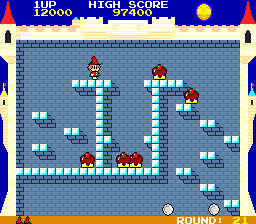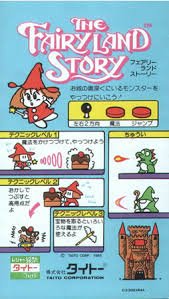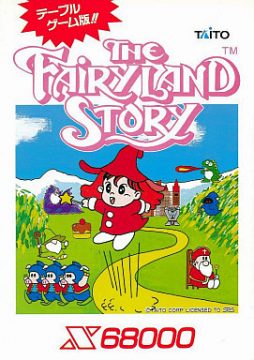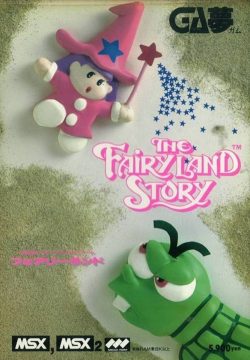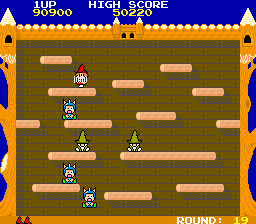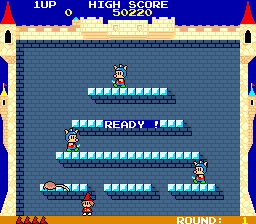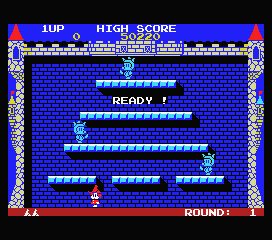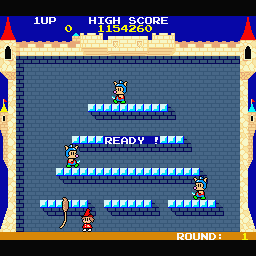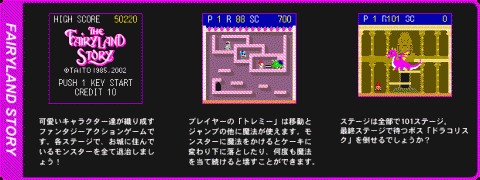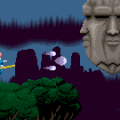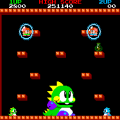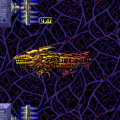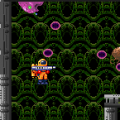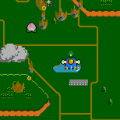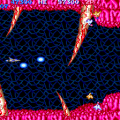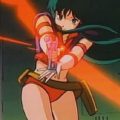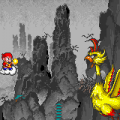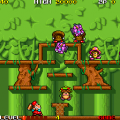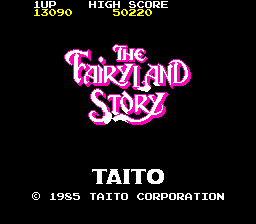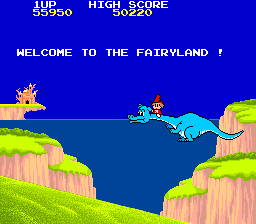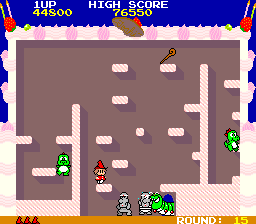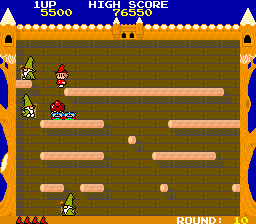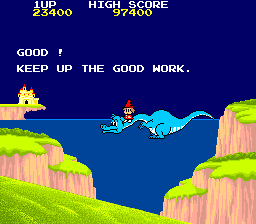Anyone with an average knowledge of video games is well aware of what Bubble Bobble is, and give it much praise (well-deserved praise, mind). What many people don’t realize is that Taito took ideas from two of their own games to create what many people consider to be one of Taito’s masterpieces, second only to Space Invaders. The two games that Bubble Bobble took inspiration from in question are Chack’n Pop and The Fairyland Story. While Mr. Chack’n (and his enemies) have become quite important characters in the Bubble Bobble series, Bubble Bobble took some of the gameplay elements from The Fairyland Story, and refined those elements into the game everyone knows and loves. While Bubble Bobble (and Chack’n Pop, to a lesser extent) is remembered by many, The Fairyland Story is not so lucky, being often largely forgotten (but might ring a bell if you’ve played Rainbow Islands, in which one of the secret islands is based on it), and when it is remembered, is often dismissed as a “Bubble Bobble clone” when really, that is not the truth at all, when it came out a full year before Bubble Bobble, for one. While it does indeed share gameplay elements with Bubble Bobble, and should be recognized as one of the stepping stones to it, The Fairyland Story is quite a different game otherwise.
Developed and published by Taito in 1985, The Fairyland Story is a single-screen platformer game that focuses on the quest of a young witch, named Ptolemy, to retrieve the Holy Gem back from the dragon/basilisk hybrid, aptly named Dracolisk. To do this, she must traverse through 101 levels and defeat all of the monsters that await in those levels. Her main attack is a weak magic spell that turns her enemies into a cake temporarily. She can either spam the attack until the enemy-turned-cake disappears, or she can push it off a ledge, and let the caked enemy fall to its death. And if other enemies are above the falling cake, they will be crushed to death. If two or more enemies were in the fall path of an caked enemy, a medal that grants bonus points will appear in the spot that they died, and so long as Ptolemy does not get killed, the bonus points that these medals grant will multiply, depending on how many have been collected, and how many enemies were crushed to death in one spot. Slight body horror aside, bonus items that give Ptolemy a temporary advantage over her enemies will also appear periodically, ranging from a staff that slows down the movement of the enemies, to a tiara that shoots down falling stars at the enemies, clearing the stage. And much like Bubble Bobble, there is a time limit on the stages. If Ptolemy takes too long to clear a stage with two or more enemies left, a flying invincible demon, named Horned, will appear and chase after Ptolemy, trying to kill her. However, if one enemy is left in the stage, the enemy will simply disappear and the game will end the current round.
For an arcade game from 1985, the game has aged well graphically, with its cute chibi-styled characters, from Ptolemy herself, to the various fantasy setting-themed enemies, being very colorful and charming, as well as well-animated. Ptolemy has quite a few death animations, too, one of them blinking at the player, looking annoyed if she gets burned by something. The stages and backdrops are pretty detailed for what they are as well. It is not too shabby sound-wise either, as it uses the MSM5232 synthesizer chip for music, a sound chip rarely used in arcade games, and uses it quite well compared to the few other arcade games that use it, making for some nice adventurous-feeling chiptunes. The highlight of the soundtrack is the song that plays in rounds 51-100, which is a nice song that gives off a feeling of perseverance. While the sound effects are driven by a more standard AY-3-8910 sound chip, the game uses that well too, as almost everything has a unique sound effect. Crushing the enemies has a surprisingly nice sound effect, and sound effect of the charging up of the dragon enemy’s (Salamander, as it is officially called) fire attack will warn you full well that you might be toasted soon. The music was composed by Tadashi Kimajima, who later did Bubble Bobble.
After you’ve heard a brief description of the game mechanics, you might ponder how it is any different from Bubble Bobble gameplay-wise. While Bubble Bobble is more suited as a game that anyone can pick up and play (a trait of most well-remembered arcade games, really), The Fairyland Story is not as forgiving, as it is slower paced, is a tad harder to control thanks to stiff jumping, and the most important detail of all, is fundamentally more of a puzzle-platformer than Bubble Bobble is. While Bubble Bobble definitely had some stages in which there was only one way to solve, The Fairyland Story takes this a couple steps further, with there being quite a lot of stages that will end a playthrough if a player does not know how to beat them. Besides the “short-hop” move (tapping the joystick in the direction of the platform you want to get on while jumping to stop the jump to get on certain platforms later in the game, round 95 in particular), and Ptolemy being able to use an enemy’s head as a semi-platform (so long as the enemy does not jump), it seems a little more basic than Bubble Bobble at first glance, but when you realize some of the stages require you to manipulate the enemy’s AI, as well as the immense amount of bonus points you’ll get from the medals and power-up items, it suddenly makes a lot more sense.
Even with the basic game mechanics in mind, The Fairyland Story employs more strategic elements than Bubble Bobble, if the actual scoring system is any indicator. Either the player can play it safe and pick out the enemies one at a time (and not get much points), or the player can put their lives (and bonus points) at risk trying to corral the enemies in one spot (and most, if not all levels have a spot for this) and gain more points that way. And if the player dies, they have to restart the level, and the bonus multiplier from the bonus medals will reset. Ouch. Bubble Bobble is more forgiving in that regard, in that it simply respawns the player when they die, and they still have somewhat of a chance to get the bonus “EXTEND” bubbles even after they have died. When the player does take the enemy AI (and the scoring system) to their advantage, however, they will rank up quite a high score, and the payoff feels rewarding and satisfying.
Adding onto this, The Fairyland Story benefits heavily on replaying it to get more of a feeling of how to beat a level in the best way possible, and while that is not a bad thing per se, that is where the biggest downfall of it is, mostly due to the fact that it is an arcade game. While it’s just easy to replay a level in a game at home, it’s not quite so easy on an arcade game. The Fairyland Story requires more patience to approach properly, and unexperienced players will also suffer quite a bit if they do not know about the deeper mechanics of it, something that is Ill-suited for an arcade game, and its successor, Bubble Bobble, does not suffer from this as much, which is the reason Bubble Bobble succeeded and The Fairyland Story didn’t as an arcade game. While the game is difficult at times, it is also surprisingly easy to cheese your way out of a level by trying to spawn one of the few level-clearing power-ups (by making Ptolemy walk as much as possible), which have a tendency to appear pretty frequently. The arcade version also only lets you continue on rounds 8-98, which was typical for Taito games at the time, but still pretty mean, as rounds 99-101 are extremely hard. Another criticism of The Fairyland Story is that the alternating two-player mode is tacked-on (like with most arcade games of the time), as the game is a single-player game first and foremost. However, if the player has enough patience to not dismiss it as a “Bubble Bobble clone” like most people do, take the time to learn it, and put up with its minor flaws, they are left with a great puzzle-platformer game with some of the best stylized graphics 1985 had to offer. The Fairyland Story is highly recommended if you are into cute platformer games and/or Bubble Bobble-like games, want a challenging game to burn through, or want to learn more about Taito’s history.
Now for some miscellaneous information. There exists USA and Japan romsets for The Fairyland Story, but there doesn’t seem to be any (visible) differences between the two. As for ports of the game, aside from emulations of the original arcade version appearing on Taito Memories Joukan, Taito Legends 2, and Taito Legends Power-Up/Taito Memories Pocket, there have been only three non-emulated ports of the game, all of which are Japan-exclusive. The first and oldest of these ports is the MSX version. Developed by GA-Yume, and published by Hot-B in 1987, the MSX port is severely downgraded from the arcade version, but still retains most of the charm the arcade version has. To perhaps make up for the downgrade in graphics, sound, and the number of enemies on-screen at once, the MSX version added quite a lot of new stages (some of which are more puzzle-like than any stage in the arcade version), as well as two enemies exclusive to this version, a variant of the Golem enemy that is immune to Ptolemy’s magic, as well as a goblin that uses the very same cake spell as Ptolemy. It also has two endings, a bad ending if you continue, and the good ending if you don’t. The manual included with this version even adds some nice context to the (almost non-existent) plot. It’s a pretty good port if you have already played the arcade version front-to-back, and want some more content to go through.
The second of these ports, and the best way to play The Fairyland Story, is the Sharp X68000 version, developed and published by SPS in 1992. It is an exact port of the arcade version besides a couple of new options. These options being number of lives to start with, wanting to continue or not when you game over (and this version lifts the weird continue rule the original arcade version has), screen resolution, and quite surprisingly, the choice between two OSTs. The “Original” OST is an approximation of the arcade version’s OST, while the “Arrange” OST is a remixed OST made for the X68000’s sound hardware in mind. Most of the remixes found in the new OST are good, although hearing the X68000 trying to emulate the sound hardware of the original version is pretty neat. Perhaps the most important part of this port, however, is that it saves your progress when you game over, as well as high scores when you get one (although the high score saving is a bit redundant if you’ve already beaten the game). This is a godsend, because going back to how you really need to replay some levels in order to master them fully, this port allows you do just that, so long as you have beaten the level already.
The third, and the most mysterious of these ports, is a mobile phone port released for I-mode and Ezweb-based phones in Japan around 2002. Not much information exists on this port, aside from some screenshots, as well as some of the music from the port appearing on the “TAITO MOBILE PHONE GAME SOUND COLLECTION Vol.1” album. Aside from the graphics being heavily downscaled for the small mobile phone screens at the time, it seems like a faithful conversion of the arcade version.
